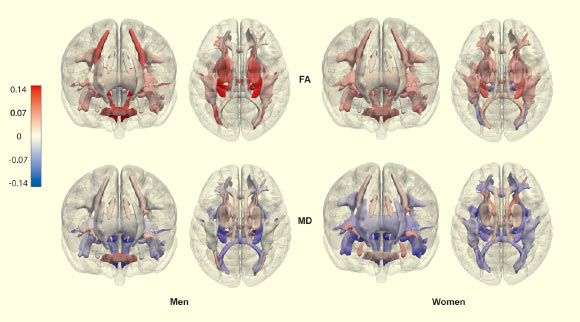A team of researchers in the Netherlands has found that higher levels of body fat are associated with differences in the form and structure of the brain, including smaller volumes of gray matter.

Overview of observed standardized regression coefficients (b values) for the associations between total body fat and fractional anisotropy (FA)- and mean diffusivity (MD)-based DTI tracts for men and women. Standardized regression coefficients reflect the standard deviation (SD) change in FA and MD, respectively, per standard deviation (6.5% in women and 5.5% in men) change in total body fat. Results were adjusted for age, ethnicity, Townsend deprivation index, assessment center (baseline visit and imaging visit), smoking, alcohol use, diabetes, cardiovascular disease, and intracranial volume. Image credit: Dekkers et al, doi: 10.1148/radiol.2019181012.
“We found that having higher levels of fat distributed over the body is associated with smaller volumes of important structures of the brain, including gray matter structures that are located in the center of the brain,” said lead author Dr. Ilona Dekkers, a researcher at the Leiden University Medical Center.
“Interestingly, we observed that these associations are different for men and women, suggesting that gender is an important modifier of the link between fat percentage and the size of specific brain structures.”
Obesity represents one of the world’s most challenging public health problems. The global pandemic has led to a greater incidence of cardiovascular disease and type 2 diabetes. Previous studies have tied obesity to an increased risk of accelerated cognitive decline and dementia, suggesting that the disease causes changes to the brain.
To learn more about these changes, Dr. Dekkers and her colleagues from the Leiden University Medical Center, VU University and the Erasmus University Medical Center analyzed brain imaging results from 12,087 participants (52.8% women; mean age – 62 years; age range – 45-76 years) in the UK Biobank study. MRI provided information on both the gray and white matter.
“Analysis showed that, in men, total body fat percentage was inversely associated with brain gray matter volume: 5.5% greater total body fat percentage was associated with 3,162 mm3 lower gray matter volume,” the scientists said.
“In men, 5.5% greater total body fat percentage was associated with 27 mm3 smaller globus pallidus volume; in women, 6.6% greater total body fat percentage was associated with 11.2 mm3 smaller globus pallidus volume.”
“Total body fat percentage was positively associated with greater global fractional anisotropy in both sexes and lower global mean diffusivity in women.”
Smaller gray matter volume suggests loss of neurons, and changes to the white matter could adversely affect the transmission of signals within brain networks.
“Since the smaller subcortical gray matter volumes are also known to play a role in the food-reward circuitry, these changes may also make it more difficult for obese people to control their weight, although more research will be needed to support that connection,” Dr. Dekkers said.
The reason for obesity’s adverse effects on the brain is not precisely known.
“The low-grade inflammation characteristic of obesity can have harmful effects on brain tissue. There is evidence that cellular responses produced in the brain due to inflammation may be behind these effects,” the researchers said.
“The study looked at overall body fat percentage and did not distinguish between the different types of fat in the body, which may be an area for additional research. Of particular interest is the visceral white fat found around the abdominal organs. This type of fat is part of metabolic syndrome,” Dr. Dekkers added.
The findings were published in the journal Radiology.
_____
Ilona A. Dekkers et al. Obesity, Brain Volume, and White Matter Microstructure at MRI: A Cross-sectional UK Biobank Study. Radiology, published online April 23, 2019; doi: 10.1148/radiol.2019181012







